HONDA CIVIC 1991 Manual PDF
Manufacturer: HONDA, Model Year: 1991, Model line: CIVIC, Model: HONDA CIVIC 1991Pages: 136, PDF Size: 1.33 MB
Page 71 of 136
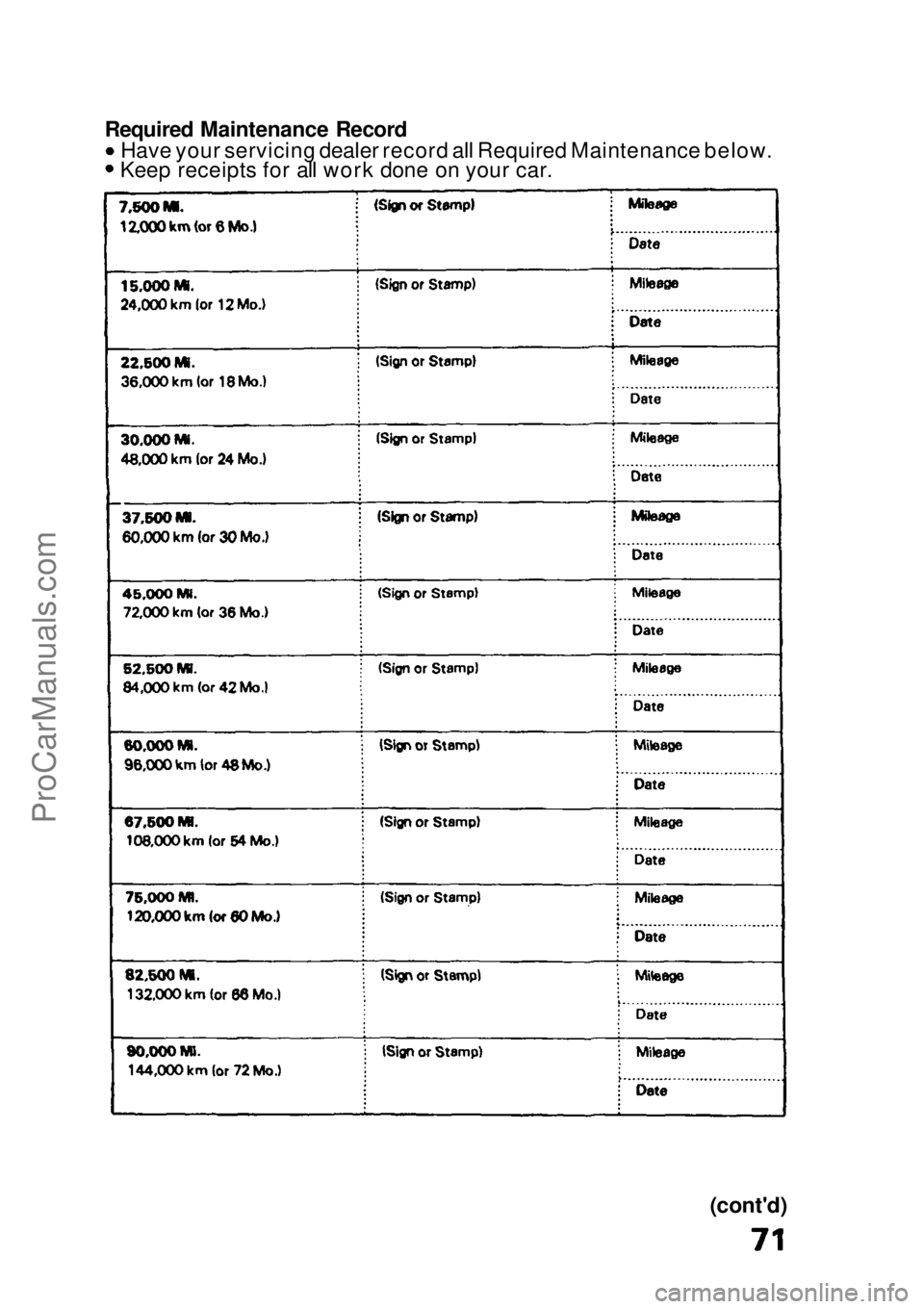
Required Maintenance Record
Have your servicing dealer record all Required Maintenance below.
Keep receipts for all work done on your car.
(cont'd)ProCarManuals.comMain Menu s t
Page 72 of 136
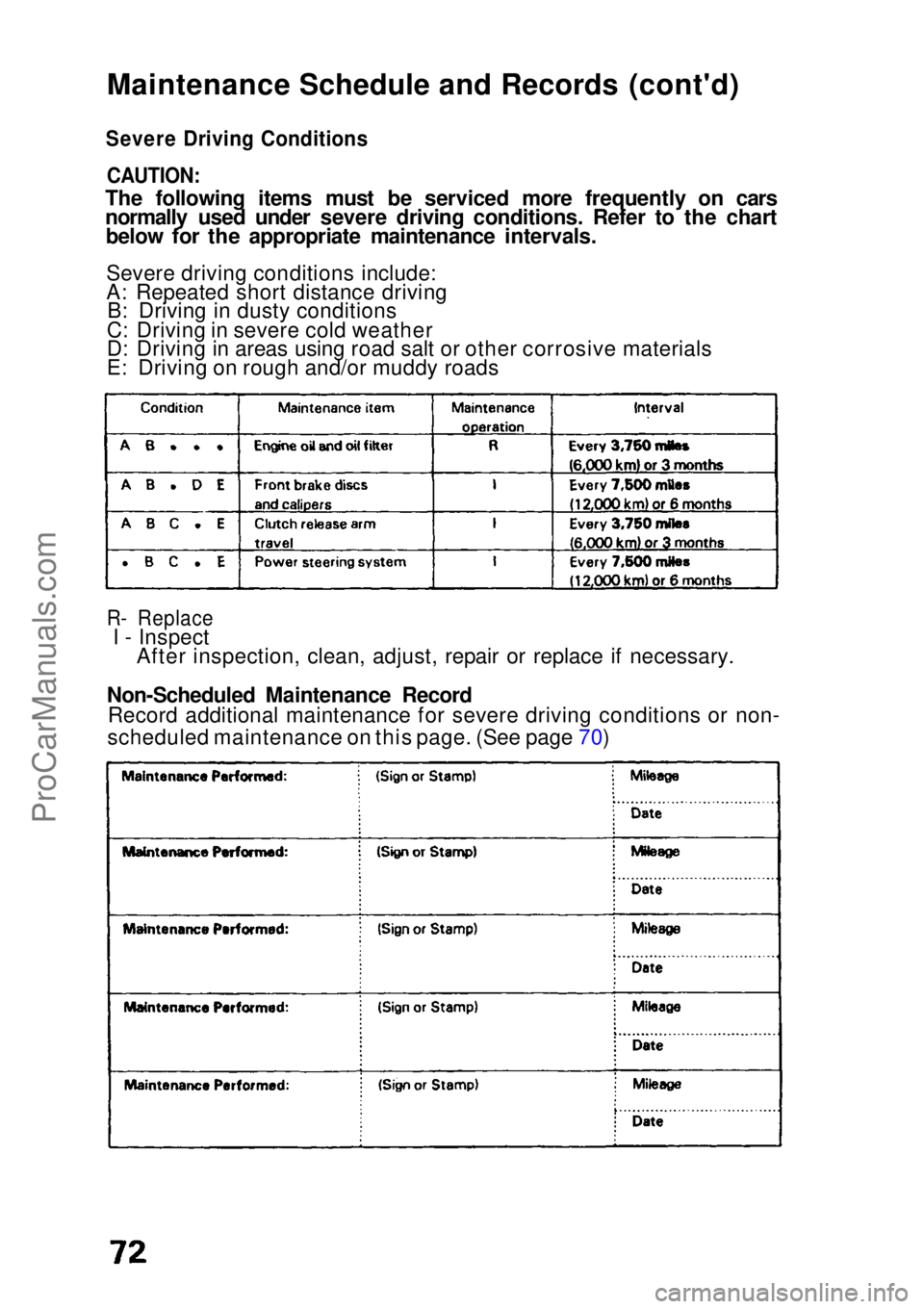
Maintenance Schedule and Records (cont'd)
Severe Driving Conditions
CAUTION:
The following items must be serviced more frequently on cars
normally used under severe driving conditions. Refer to the chart below for the appropriate maintenance intervals.
Severe driving conditions include:
A: Repeated short distance driving B: Driving in dusty conditions
C: Driving in severe cold weather
D: Driving in areas using road salt or other corrosive materials
E: Driving on rough and/or muddy roads
R- Replace
I - Inspect After inspection, clean, adjust, repair or replace if necessary.
Non-Scheduled Maintenance Record Record additional maintenance for severe driving conditions or non-
scheduled maintenance on this page. (See page 70)ProCarManuals.comMain Menu s t
Page 73 of 136
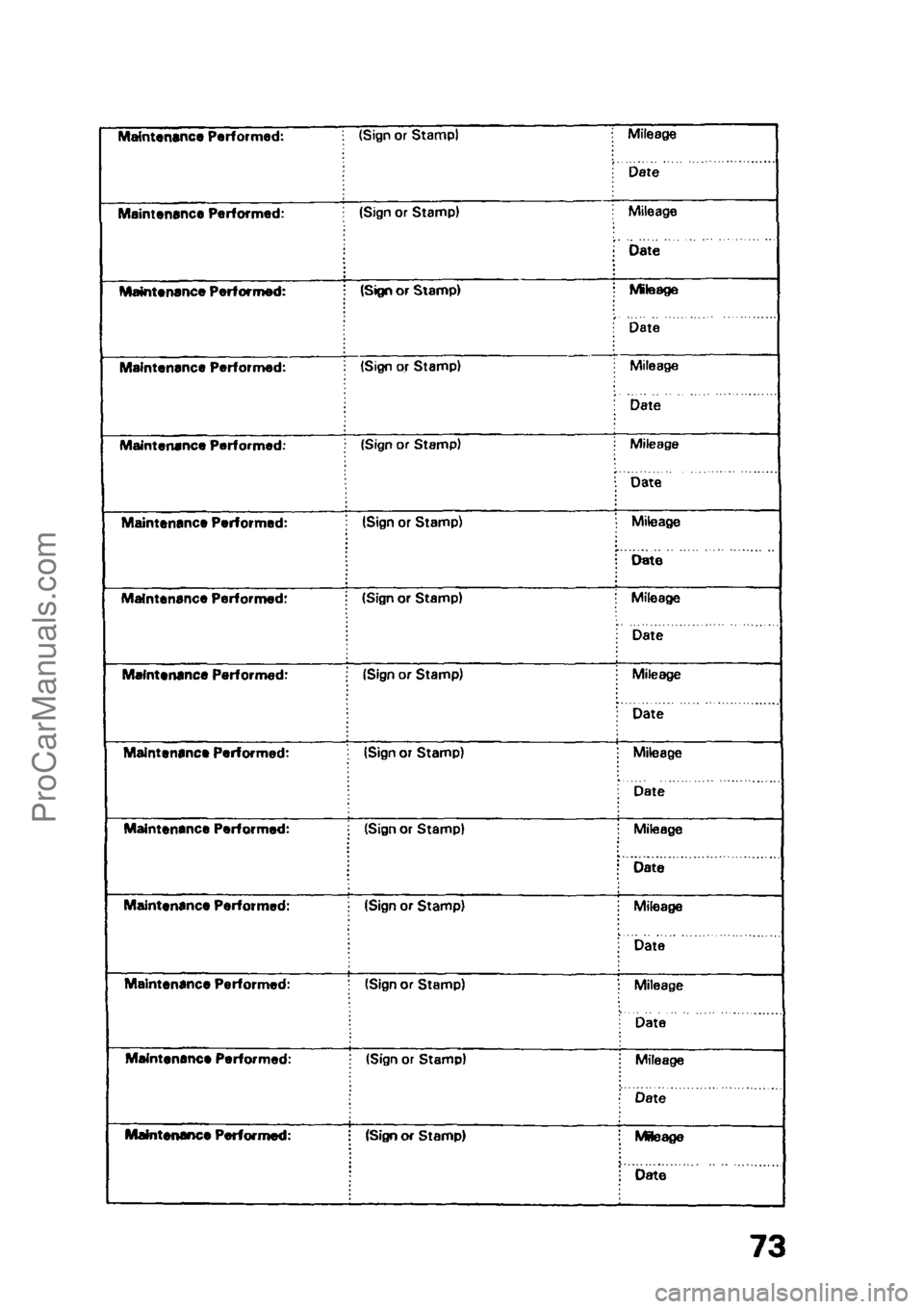
ProCarManuals.comMain Menu s t
Page 74 of 136
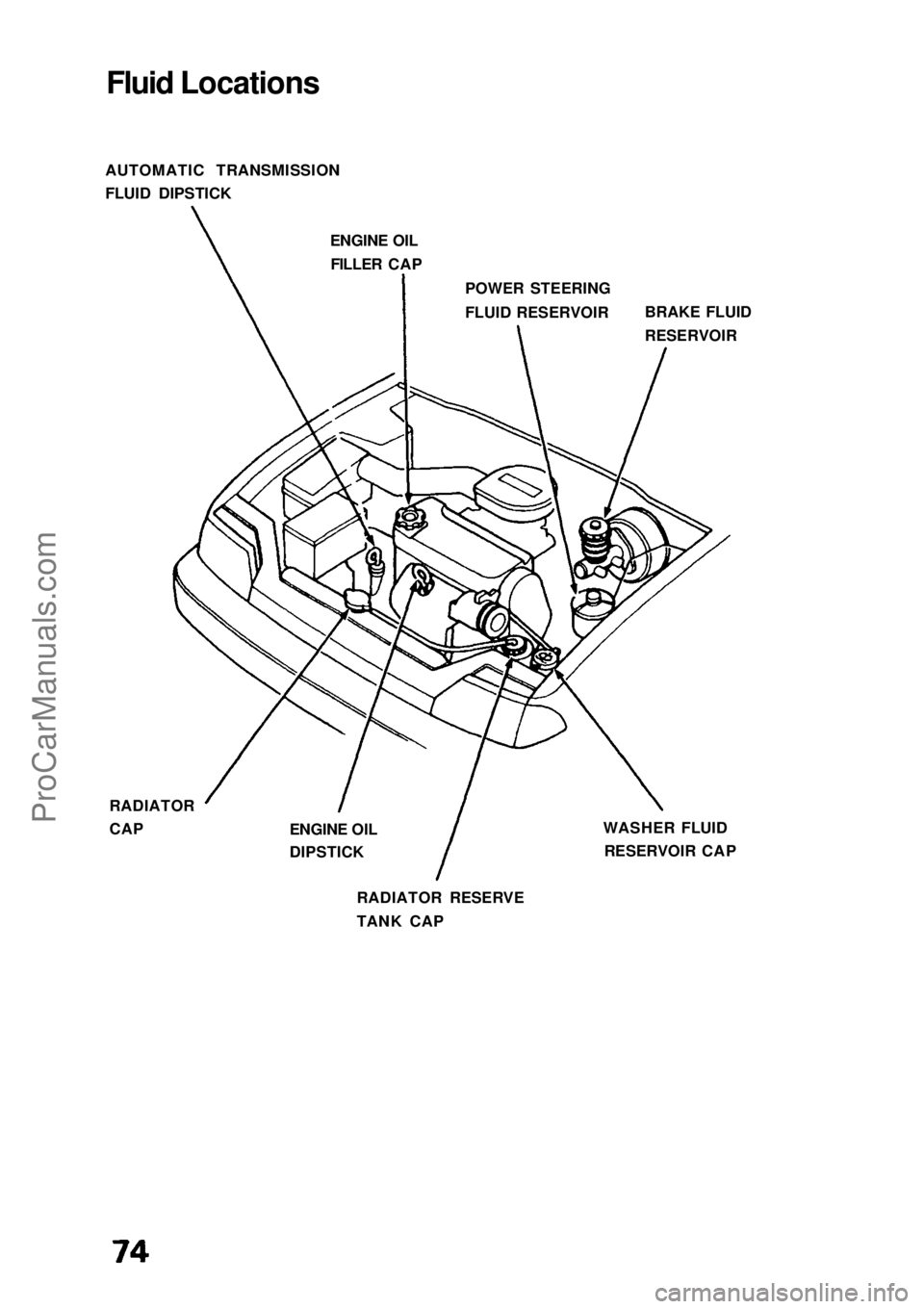
Fluid Locations
AUTOMATIC TRANSMISSION
FLUID DIPSTICK ENGINE OILFILLER CAP
POWER STEERING
FLUID RESERVOIR
RADIATOR
CAP WASHER FLUID
RESERVOIR CAP
RADIATOR RESERVE
TANK CAP BRAKE FLUID
RESERVOIR
ENGINE OIL
DIPSTICKProCarManuals.comMain Menu s t
Page 75 of 136
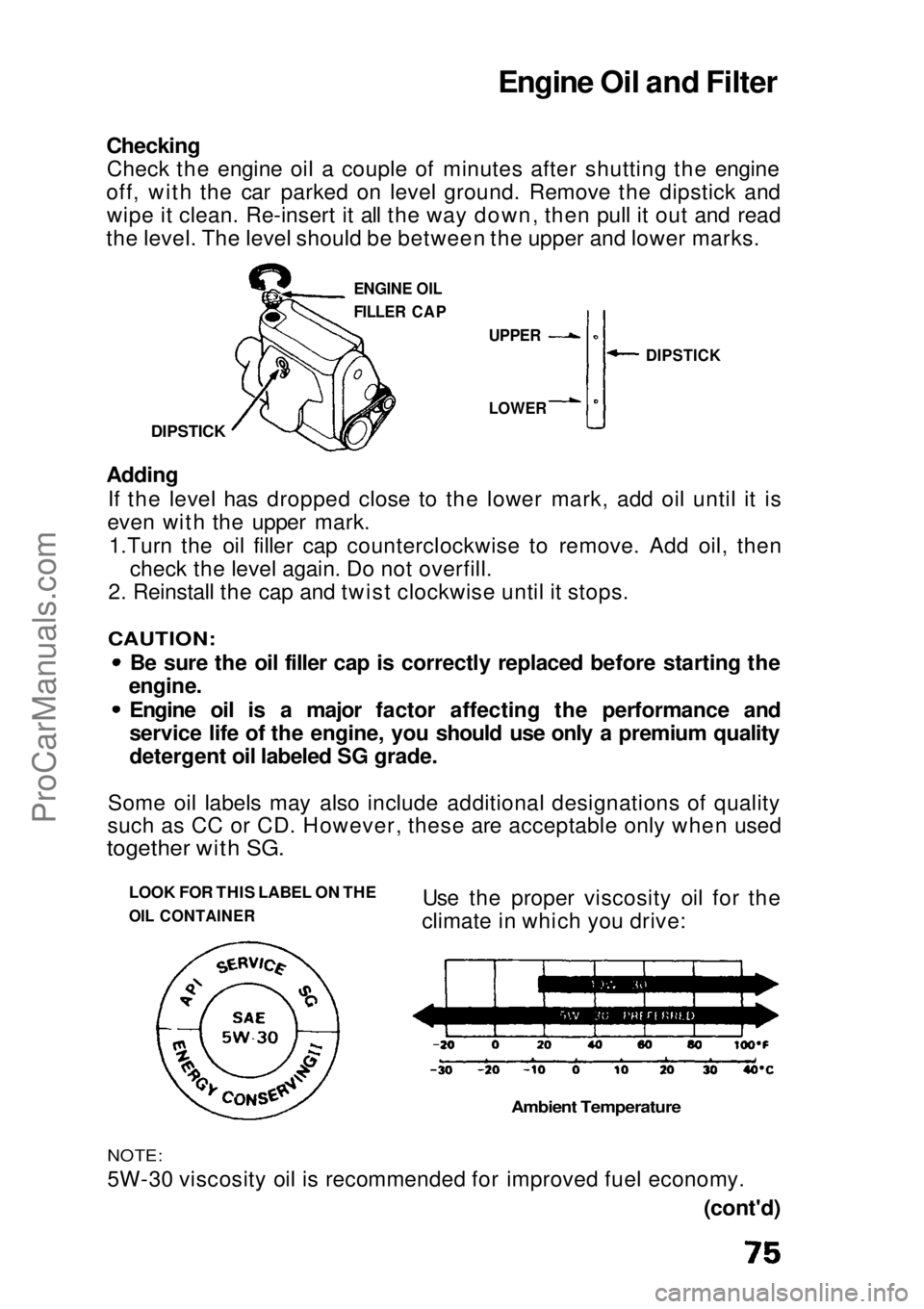
Engine Oil and Filter
Checking
Check the engine oil a couple of minutes after shutting the engine
off, with the car parked on level ground. Remove the dipstick and wipe it clean. Re-insert it all the way down, then pull it out and read
the level. The level should be between the upper and lower marks.
DIPSTICK
ENGINE OIL
FILLER CAP
Adding
If the level has dropped close to the lower mark, add oil until it is
even with the upper mark.
1.Turn the oil filler cap counterclockwise to remove. Add oil, then check the level again. Do not overfill.
2. Reinstall the cap and twist clockwise until it stops.
CAUTION:
Be sure the oil filler cap is correctly replaced before starting the
engine.
Engine oil is a major factor affecting the performance and
service life of the engine, you should use only a premium quality
detergent oil labeled SG grade.
Some oil labels may also include additional designations of quality
such as CC or CD. However, these are acceptable only when used
together with SG.
LOOK FOR THIS LABEL ON THE
OIL CONTAINER
Use the proper viscosity oil for the
climate in which you drive:
Ambient Temperature
NOTE:
5W-30 viscosity oil is recommended for improved fuel economy.
(cont'd)
DIPSTICK
LOWER UPPERProCarManuals.comMain Menu s t
Page 76 of 136
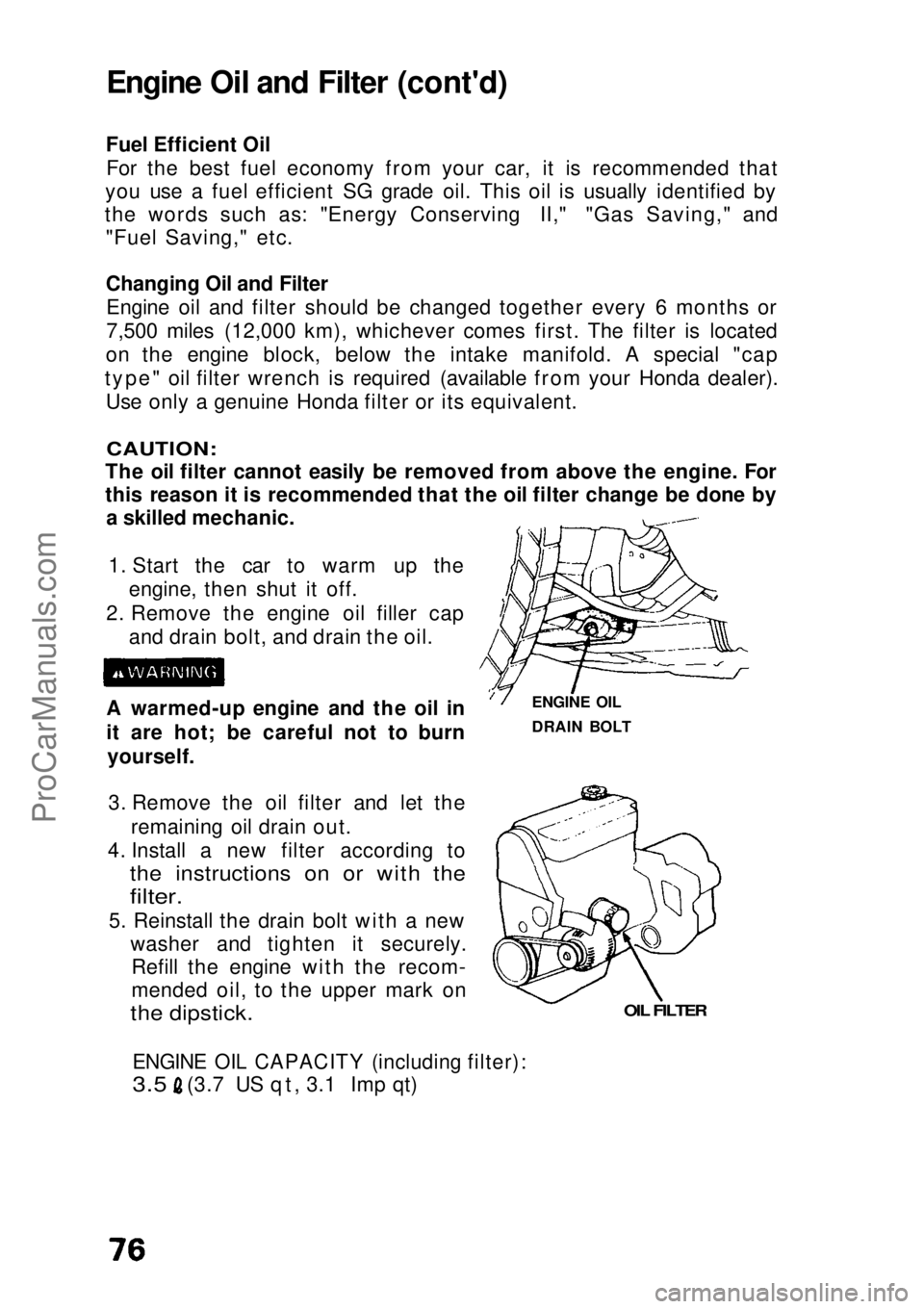
Engine Oil and Filter (cont'd)
Fuel Efficient Oil For the best fuel economy from your car, it is recommended that
you use a fuel efficient SG grade oil. This oil is usually identified by
the words such as: "Energy Conserving II," "Gas Saving," and "Fuel Saving," etc.
Changing Oil and Filter
Engine oil and filter should be changed together every 6 months or
7,500 miles (12,000 km), whichever comes first. The filter is located
on the engine block, below the intake manifold. A special "cap
type" oil filter wrench is required (available from your Honda dealer). Use only a genuine Honda filter or its equivalent.
CAUTION:
The oil filter cannot easily be removed from above the engine. For
this reason it is recommended that the oil filter change be done by a skilled mechanic.
1. Start the car to warm up the engine, then shut it off.
2. Remove the engine oil filler cap and drain bolt, and drain the oil.
A warmed-up engine and the oil in
it are hot; be careful not to burn yourself.
3. Remove the oil filter and let the remaining oil drain out.
4. Install a new filter according to
the instructions on or with the
filter.
5. Reinstall the drain bolt with a new washer and tighten it securely.Refill the engine with the recom-
mended oil, to the upper mark on
the dipstick.
ENGINE OIL CAPACITY (including filter):
3.5
(3.7 US qt, 3.1 Imp qt)
OIL FILTER
ENGINE OIL
DRAIN BOLTProCarManuals.comMain Menu s t
Page 77 of 136

6. Reinstall the filler cap securely.
7. Start the engine and make sure oil is not leaking from the drain
bolt or the filter.
8. Shut off the engine and recheck the oil level.
NOTE:Please dispose of used motor oil in a manner that is compatible with
the environment. We suggest you take it in a sealed container to
your local service station for reclamation. Do not throw it in the
trash or pour it on the ground.
CAUTION:
Used motor oil may cause skin cancer if repeatedly left in contact
with the skin for prolonged periods. Although this is unlikely
unless you handle used oil on a daily basis, it is still advisable to
thoroughly wash your hands with soap and water as soon as possible after handling used oil.ProCarManuals.comMain Menu s t
Page 78 of 136
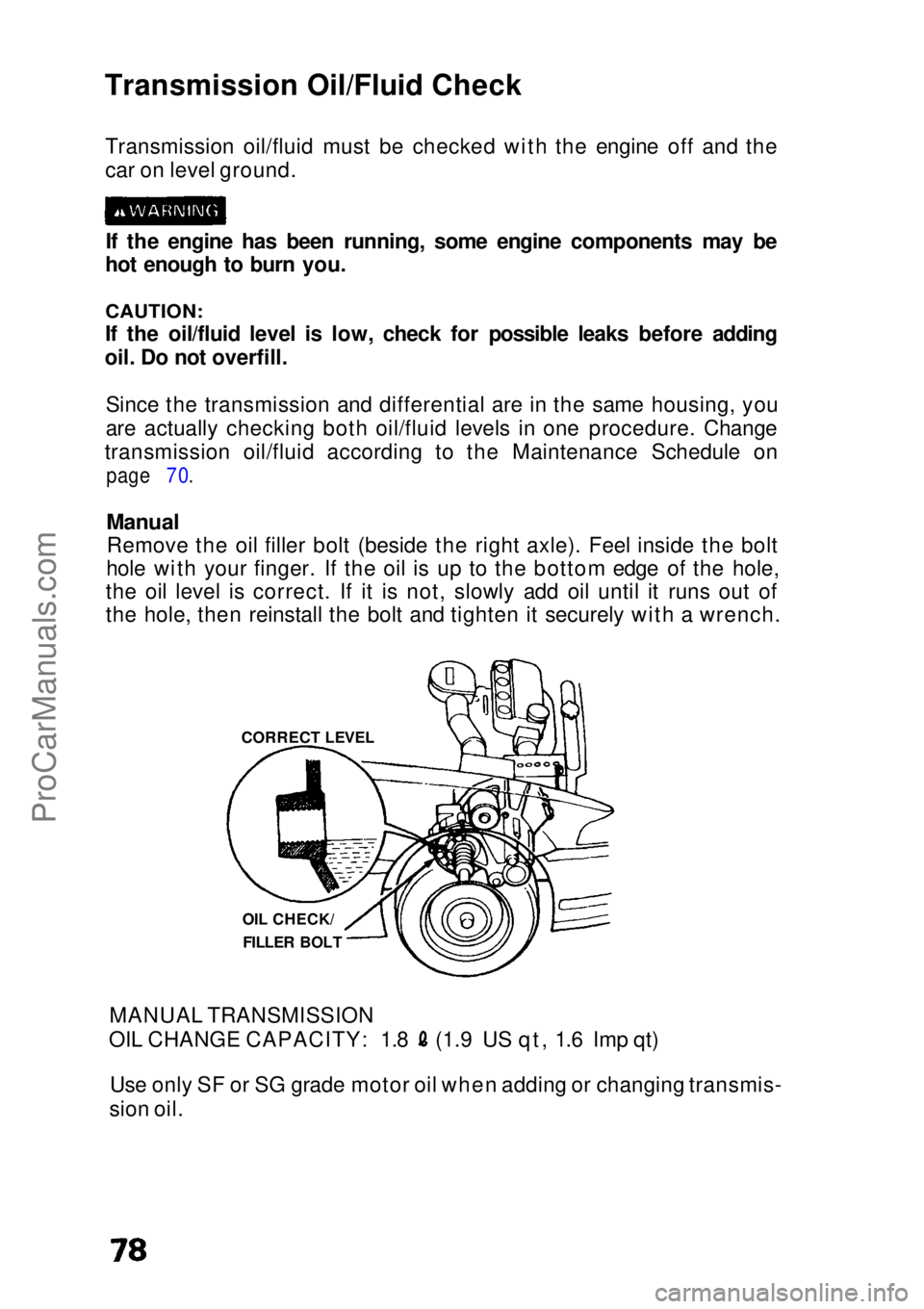
Transmission Oil/Fluid Check
Transmission oil/fluid must be checked with the engine off and the
car on level ground.
If the engine has been running, some engine components may be
hot enough to burn you.
CAUTION:
If the oil/fluid level is low, check for possible leaks before adding
oil. Do not overfill.
Since the transmission and differential are in the same housing, you
are actually checking both oil/fluid levels in one procedure. Change
transmission oil/fluid according to the Maintenance Schedule on
page 70.
Manual
Remove the oil filler bolt (beside the right axle). Feel inside the bolt
hole with your finger. If the oil is up to the bottom edge of the hole,
the oil level is correct. If it is not, slowly add oil until it runs out of
the hole, then reinstall the bolt and tighten it securely with a wrench.
MANUAL TRANSMISSION OIL CHANGE CAPACITY: 1.8 (1.9 US qt, 1.6 Imp qt)
Use only SF or SG grade motor oil when adding or changing transmis-
sion oil. OIL CHECK/
FILLER BOLT
CORRECT LEVELProCarManuals.comMain Menu s t
Page 79 of 136
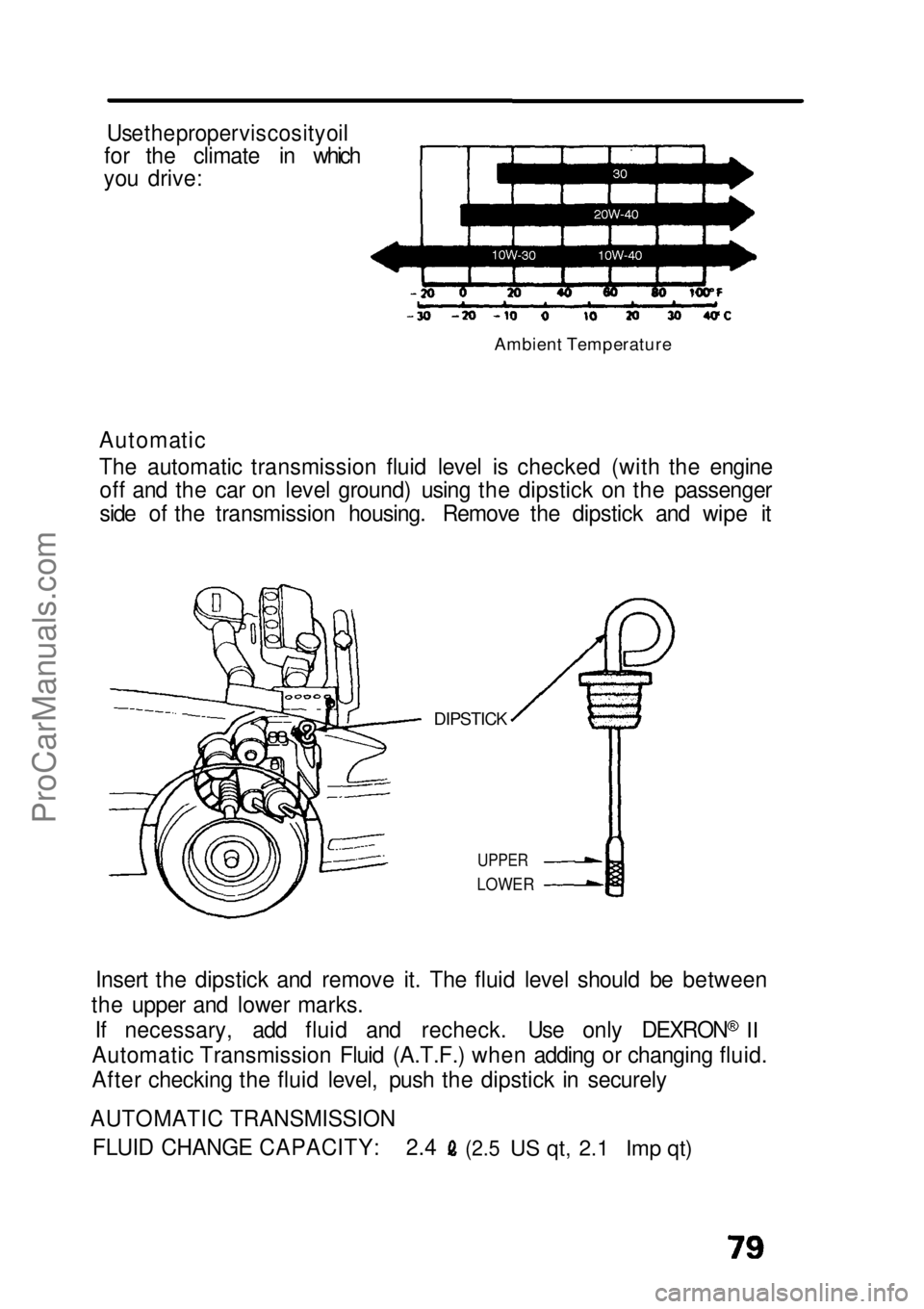
Use the proper viscosity oil
for the climate in which
you drive:
Ambient Temperature
Automatic
The automatic transmission fluid level is checked (with the engine off and the car on level ground) using the dipstick on the passenger
side of the transmission housing. Remove the dipstick and wipe it
DIPSTICK
UPPER
LOWER
Insert the dipstick and remove it. The fluid level should be between
the upper and lower marks. If necessary, add fluid and recheck. Use only DEXRON
Automatic Transmission Fluid (A.T.F.) when adding or changing fluid.
After checking the fluid level, push the dipstick in securely
AUTOMATIC TRANSMISSION FLUID CHANGE CAPACITY: 2.4 (2.5
US qt, 2.1 Imp qt)ProCarManuals.comMain Menu s t
Page 80 of 136

Cooling System
The engine in your Honda contains a number of aluminum parts. Therefore, it requires an antifreeze/coolant specifically formulated
to protect the aluminum parts from corrosion. Failure to use asuitable antifreeze/coolant may seriously shorten the life of the
engine as the result of rapid corrosion damage. Some antifreeze/
coolants, although labelled for use in engines containing aluminum,may not provide adequate protection for your engine.
Therefore, use only a Honda RECOMMENDED antifreeze/coolant.
CHECK WITH YOUR AUTHORIZED HONDA DEALER.
For best corrosion protection, the mixture of coolant and water
must be maintained year-round at 50/50. Concentrations less than 50% coolant may not provide sufficient protection against
corrosion and freezing. Concentrations of greater than 60% coolant
will impair cooling efficiency and are not recommended. Low- mineral drinking water or distilled water should be mixed with the
antifreeze/coolant. Coolant loss should be replenished by a mixture
containing the proper concentration of antifreeze and water.Do not mix different antifreeze/coolants.
Do not use additional rust inhibitors or anti-rust products, as they
may not be compatible with the radiator coolant.
ENGINE DAMAGE CAUSED BY IMPROPER COOLANT USAGE IS
NOT COVERED BY THE NEW CAR WARRANTY.
Checking Coolant
Check the coolant level in the reserve tank when the engine is at
normal operating temperature.
Do not remove the radiator cap when the engine is hot; the
coolant is under pressure and could severely scald you.ProCarManuals.comMain Menu s t